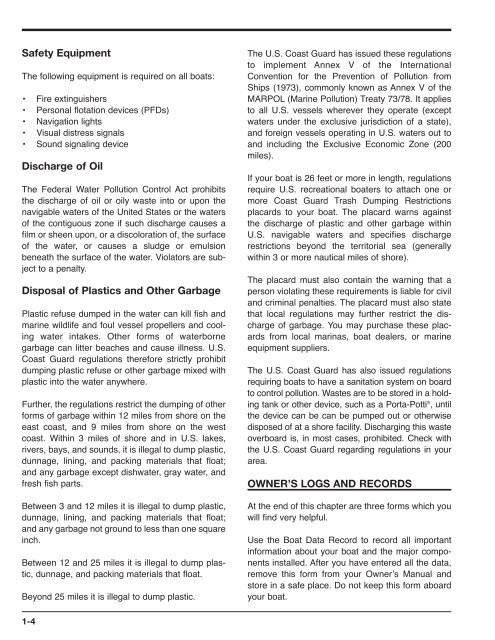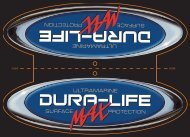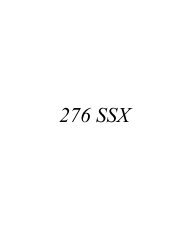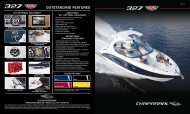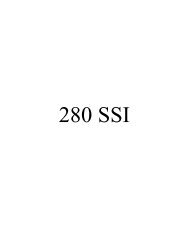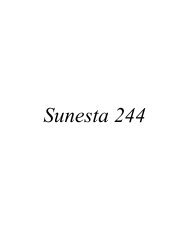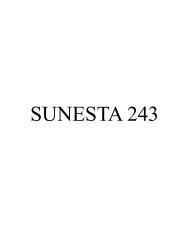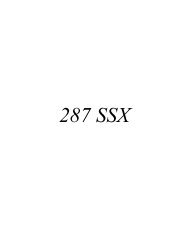OWNER'S/OPERATOR'S MANUAL - Chaparral Boats Owners Club
OWNER'S/OPERATOR'S MANUAL - Chaparral Boats Owners Club
OWNER'S/OPERATOR'S MANUAL - Chaparral Boats Owners Club
You also want an ePaper? Increase the reach of your titles
YUMPU automatically turns print PDFs into web optimized ePapers that Google loves.
Safety EquipmentThe following equipment is required on all boats:• Fire extinguishers• Personal flotation devices (PFDs)• Navigation lights• Visual distress signals• Sound signaling deviceDischarge of OilThe Federal Water Pollution Control Act prohibitsthe discharge of oil or oily waste into or upon thenavigable waters of the United States or the watersof the contiguous zone if such discharge causes afilm or sheen upon, or a discoloration of, the surfaceof the water, or causes a sludge or emulsionbeneath the surface of the water. Violators are subjectto a penalty.Disposal of Plastics and Other GarbagePlastic refuse dumped in the water can kill fish andmarine wildlife and foul vessel propellers and coolingwater intakes. Other forms of waterbornegarbage can litter beaches and cause illness. U.S.Coast Guard regulations therefore strictly prohibitdumping plastic refuse or other garbage mixed withplastic into the water anywhere.Further, the regulations restrict the dumping of otherforms of garbage within 12 miles from shore on theeast coast, and 9 miles from shore on the westcoast. Within 3 miles of shore and in U.S. lakes,rivers, bays, and sounds, it is illegal to dump plastic,dunnage, lining, and packing materials that float;and any garbage except dishwater, gray water, andfresh fish parts.Between 3 and 12 miles it is illegal to dump plastic,dunnage, lining, and packing materials that float;and any garbage not ground to less than one squareinch.Between 12 and 25 miles it is illegal to dump plastic,dunnage, and packing materials that float.Beyond 25 miles it is illegal to dump plastic.The U.S. Coast Guard has issued these regulationsto implement Annex V of the InternationalConvention for the Prevention of Pollution fromShips (1973), commonly known as Annex V of theMARPOL (Marine Pollution) Treaty 73/78. It appliesto all U.S. vessels wherever they operate (exceptwaters under the exclusive jurisdiction of a state),and foreign vessels operating in U.S. waters out toand including the Exclusive Economic Zone (200miles).If your boat is 26 feet or more in length, regulationsrequire U.S. recreational boaters to attach one ormore Coast Guard Trash Dumping Restrictionsplacards to your boat. The placard warns againstthe discharge of plastic and other garbage withinU.S. navigable waters and specifies dischargerestrictions beyond the territorial sea (generallywithin 3 or more nautical miles of shore).The placard must also contain the warning that aperson violating these requirements is liable for civiland criminal penalties. The placard must also statethat local regulations may further restrict the dischargeof garbage. You may purchase these placardsfrom local marinas, boat dealers, or marineequipment suppliers.The U.S. Coast Guard has also issued regulationsrequiring boats to have a sanitation system on boardto control pollution. Wastes are to be stored in a holdingtank or other device, such as a Porta-Potti ® , untilthe device can be can be pumped out or otherwisedisposed of at a shore facility. Discharging this wasteoverboard is, in most cases, prohibited. Check withthe U.S. Coast Guard regarding regulations in yourarea.OWNER’S LOGS AND RECORDSAt the end of this chapter are three forms which youwill find very helpful.Use the Boat Data Record to record all importantinformation about your boat and the major componentsinstalled. After you have entered all the data,remove this form from your Owner’s Manual andstore in a safe place. Do not keep this form aboardyour boat.1-4


